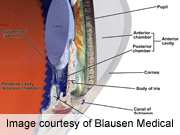
THURSDAY, Sept. 11, 2014 (HealthDay News) — A novel study of mice has shed new light on the molecular basis for glaucoma, which is a leading cause of blindness in the United States.
Based on their findings, researchers from Northwestern University Feinberg School of Medicine in Chicago said they are working to develop eye drops that might one day cure the disease in people.
“This is a big step forward in understanding the cause of the disease that steals the eyesight from 60 million people worldwide,” study senior author Dr. Susan Quaggin, a Northwestern nephrologist, said in a university news release. “This gives us a foothold to develop new treatments.”
Glaucoma, which has no cure, blocks the drainage of fluid from the eye, which then builds up pressure that can damage the retina and the optic nerve.
The vessel that is essential for proper drainage in the eye is known as Schlemm’s canal. Using a mouse model of glaucoma, the researchers identified a chemical signaling pathway that is essential for growth, development and proper functioning of the canal. The pathway requires a substance called Tie2 and a growth factor called angiopoietin. If either was missing, the mice were not able to make Schlemm’s canals and developed glaucoma, reports the study, published Sept. 9 in The Journal of Clinical Investigation.
“We really nailed that pathway as being critical,” Quaggin noted. “Now we know these two substances are key factors in the development of glaucoma, which wasn’t known before.”
Although the study involved mice, and animal studies often fail to produce similar results in humans, the researchers said their findings are expected to be relevant for glaucoma in people. Both Tie2 and angiopoietin are likely involved in human glaucoma, they suggested.
“The mouse model is so similar to what we see in patients with glaucoma,” said Quaggin. “Now we can understand how raised pressure leads to the damage of the neurons in the optic nerve.”
Quaggin, who is director of the Feinberg Cardiovascular Research Institute and chief of nephrology and hypertension at Feinberg and Northwestern Memorial Hospital, is working with a team of scientists to develop an eye drop that triggers regrowth of the clogged vessel, or Schlemm’s canal.
“Our goal now is to grow new ‘pipes’ or vessels to cure the glaucoma,” concluded Quaggin, who is also the Charles Mayo Chair of Medicine at Feinberg. “Just imagine if we could grow a bigger Schlemm’s canal in anybody with glaucoma to lower the pressure in the eye. That’s what we’re hoping for with this new eye drop.”
More information
The Glaucoma Research Foundation provides more information on glaucoma.
Copyright © 2025 HealthDay. All rights reserved.

